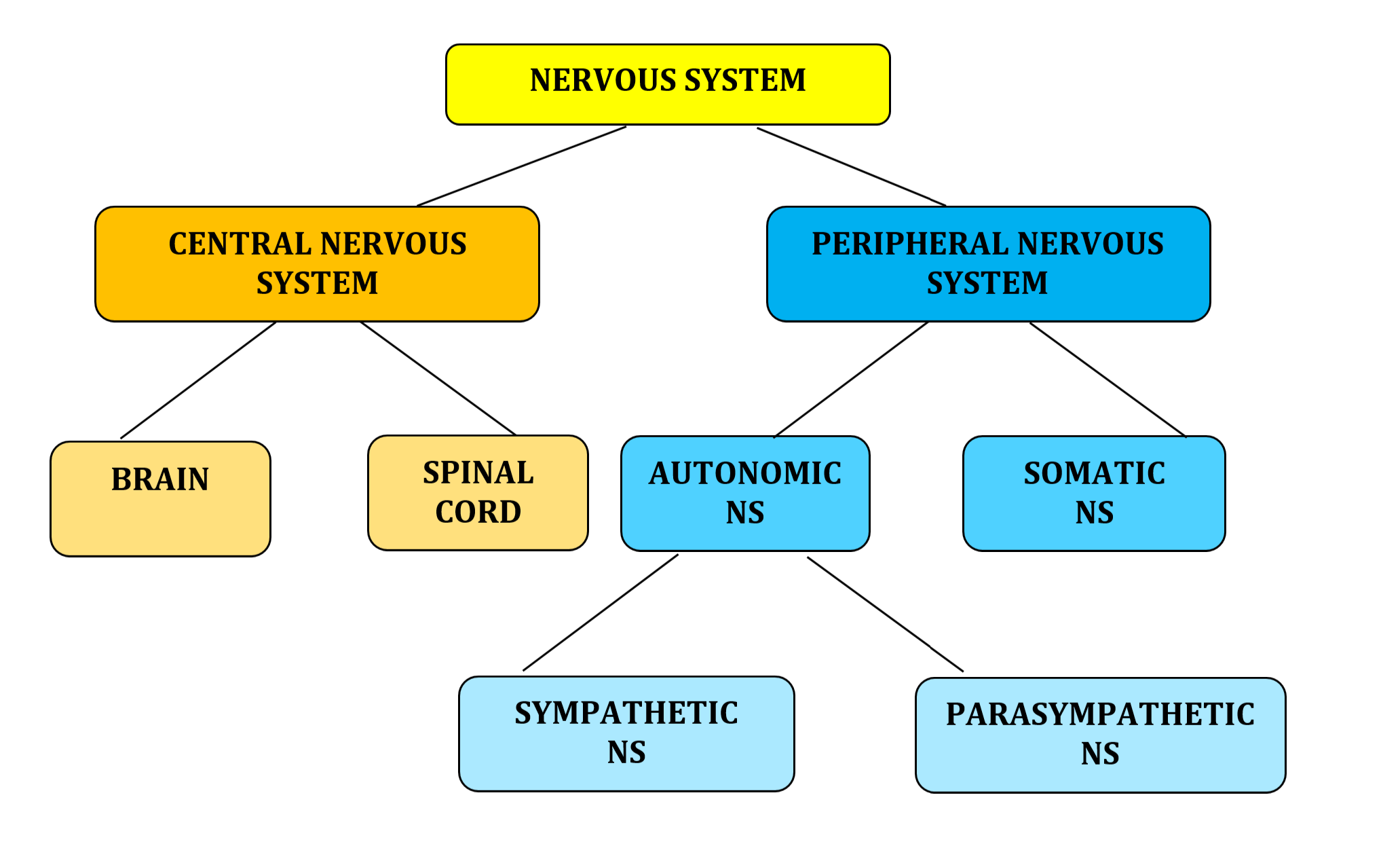21 3.3. Parts of the Nervous System
Now you have some idea about how the nervous system works on the microscopic level, let us zoom out and look at the big picture in terms of how it is organized. The nervous system can be divided into two major subdivisions: the central nervous system (CNS) and the peripheral nervous system (PNS), shown in Figure 3.8. The CNS is comprised of the brain and spinal cord, which are the control centers of the nervous system. The PNS connects the CNS to the rest of the body.
Peripheral Nervous System
The peripheral nervous system is made up of thick bundles of axons, commonly called nerves, which carry messages back and forth between the CNS and the muscles, glands, and organs in the periphery of the body (i.e., everything outside the CNS). The PNS has two major subdivisions: the somatic nervous system and the autonomic nervous system (Figure 3.8).
The somatic nervous system is associated with activities traditionally thought of as conscious or voluntary, like picking up or putting down a cup of coffee, or writing a paper. The somatic nervous system relays information about our senses (via sensory neurons) to the CNS; and brings information from the CNS to muscles, glands, and organs via motor neurons. Sensory neurons carrying sensory information into the CNS are afferent fibers (afferent means “moving toward”), whereas motor neurons carrying information from the CNS are efferent fibers. A helpful way to remember this is that efferent = exit and afferent = arrive.

The autonomic nervous system controls our internal organs and glands and is generally considered to be outside of our voluntary control. It can be further subdivided into the sympathetic and parasympathetic divisions (Figures 3.9 and 3.10.). The sympathetic nervous system is often referred to as the fight or flight system, because it is involved in preparing the body for stress-related activities. The parasympathetic nervous system is associated with resting and digesting, and returning the body to routine, day-to-day operations. The two systems have complementary functions, operating in tandem to maintain the body’s homeostasis. Homeostasis is a state of equilibrium, or balance, in which bodily functions (such as body temperature) are maintained at optimal levels.

The sympathetic nervous system is activated when we are faced with stressful or very arousing situations. This system was highly adaptive for our ancestors, as it increased their chances of survival in dangerous situations. Imagine, for example, if one of our early ancestors, suddenly disturbed a large bear. At that moment, the sympathetic nervous system would immediately activate and their body would undergo a rapid series of changes, which would prepare them to face the threat. Their pupils would dilate, their heart rate and blood pressure would increase, their bladder would relax, and their liver would releases glucose; adrenaline would surge into the bloodstream, and blood would flow to large muscles. This constellation of physiological changes allows the body access to energy reserves and provides heightened sensory capacity so that they would be able to fight off the threat or run away to safety. Once the threat has been resolved, the parasympathetic nervous system would take over and return bodily functions to a relaxed state. Their heart rate and blood pressure would return to normal, their pupils would constrict, their bladder control would be restored, and their liver would begin to store glucose in the form of glycogen for future use.
Link to Learning
Watch this video about the Freeze, Fight and Flight response to learn more. Sometimes we initially freeze when we experience a threatening situation. Freezing helps us to “hide” from potential predators, because moving objects (including people and animals) are easier to spot than stationary ones. Freezing is initiated by the parasympathetic nervous system and may be important for getting the sympathetic nervous system ready to respond (Roelofs, 2017).
While it is clear that the “fight or flight” response was critical for survival for our ancestors, who lived in a world full of physical threats, many of the highly arousing situations we face in the modern world are more psychological in nature. For example, think about how you might feel when you have to stand up and give a presentation in front of a roomful of people, or when you are about to take a big test. You are in no real physical danger in those situations, and yet you have evolved to respond with the fight or flight response. This kind of response is not nearly as adaptive in the modern world; in fact, we can suffer negative health consequences when faced constantly with psychological threats that we can neither fight nor flee. Recent research suggests that an increase in susceptibility to heart disease (Chandola et al., 2006) and impaired function of the immune system (Glaser & Kiecolt-Glaser, 2005) are among the many negative consequences of persistent and repeated exposure to stressful situations. Some of this tendency for stress reactivity can be wired by early experiences of trauma.

